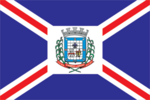Campo Largo, Paraná
Campo Largo | |
|---|---|
| Municipality of Campo Largo | |
| Nickname: Capital da louça ("The porcelain capital") | |
 Location in the Paraná | |
| Coordinates: 25°27′32″S 49°31′40″W / 25.45889°S 49.52778°W | |
| Country | |
| Region | South |
| State | |
| Founded | April 2, 1870 |
| Incorporated | February 23, 1871 |
| Government | |
| • Mayor | Edson Basso (PSDB) |
| Area | |
• Total | 1,243.552 km2 (480.138 sq mi) |
| Elevation | 956 m (3,136 ft) |
| Population (2020)[2] | |
• Total | 133,865 |
| • Density | 110/km2 (280/sq mi) |
| Time zone | UTC−3 (BRT) |
| CEP | 80000-000 to 82999-999 |
| Area code | +55 41 |
| HDI (2010) | 0.745 – high[3] |
| Website | campolargo |
Campo Largo is a municipality in Paraná, Brazil. The inhabitants are known in Brazil as campolarguense. It is also a near suburb of Curitiba. The town is best known for its large product of porcelain. It is headquarters to companies such as: 'Incepa', 'Porcelana Schmidt[4]', 'Germer', 'Lorenzetti'. 'Ouro Fino' mineral water also comes from this town.[citation needed]
History
[edit]The gold rush on Paraná in the middle of 16th century was the main reason to the first settlements which gives origin to the city. Gold extraction was followed by cattle and stop points to explorers on the way to São Paulo.
Colonization was made by the original Brazilian population of that time, mainly Portuguese and Africans, in combination with the recent immigration wave of European immigrants, mainly from Poland, Italy and Germany, which were attracted by the Brazilian government incentives and the temperate climate preferring to immigrate instead of continuing in a Europe devastated by poverty and religious prosecutions.
References
[edit]- ^ "Brazilian Institute of Geography and Statistics" (in Portuguese). 2017. Retrieved 27 March 2019.
2018 Area Total
- ^ IBGE 2020
- ^ "Archived copy" (PDF). United Nations Development Programme (UNDP). Archived from the original (PDF) on July 8, 2014. Retrieved August 1, 2013.
{{cite web}}: CS1 maint: archived copy as title (link) - ^ "MAIS DE 70 ANOS DE TRADIÇÃO".
External links
[edit]Campo Largo travel guide from Wikivoyage







